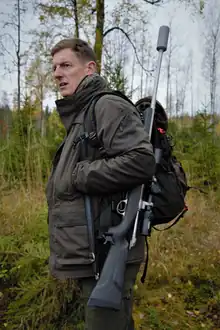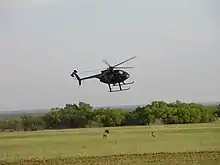
A professional hunter (less frequently referred to as market or commercial hunter and regionally, especially in Britain and Ireland, as professional stalker or gamekeeper) is a person who hunts and/or manages game by profession. Some professional hunters work in the private sector or for government agencies and manage species that are considered overabundant,[1][2] others are self-employed and make a living by selling hides and meat,[3] while still others guide clients on big-game hunts.[4]
Australia
In Australia several million kangaroos are shot each year by licensed professional hunters in population control programmes, with both their meat and hides sold.[5][6][7][8][9]
Germany
German professional hunters (Berufsjäger or Berufsjägerinnen depending on gender) mostly work for large private forest estates and for state-owned forest enterprises, where they control browsing by reducing the numbers of ungulates like roe deer or chamois, manage populations of sought-after trophy species like red deer and act as hunting guides for paying clients.[10][11][12]
Southern and Eastern Africa

The countries of Southern and Eastern Africa, especially Namibia, South Africa, Tanzania and Zimbabwe, are major destinations for big-game hunting tourism in Africa.[13][14] Local professional hunters, often simply referred to as PH, act as hunting guides for paying guest hunters and manage safari hunting businesses.[15][16][17]
Historically, professional big-game hunters of European descent who plied their trade in Africa, especially during the first half of the 20th century, are often referred to as "white hunters" or "great white hunters".[18]
United Kingdom

British professional stalkers and gamekeepers primarily work on large estates, especially in the Scottish Highlands, where they most commonly manage red deer, common pheasant, red grouse and French partridge.[19][20] Early in the 20th century there were an estimated 25,000 professional stalkers and gamekeepers employed in the UK,[21] while today there are some 3000.[22]
United States
Unregulated hunting in the 19th and early 20th century

In a North American context the terms market hunter and commercial hunter are predominantly used to refer to hunters of the 19th and early 20th century who sold or traded the flesh, bones, skins and feathers of slain animals as a source of income. These hunters focused on species which gathered in large numbers for breeding, feeding, or migration and were organized into factory-like groups that would systematically depopulate an area of any valuable wildlife over a short period of time. The animals which were hunted included bison, deer, ducks and other waterfowl, geese, pigeons and many other birds, seals and walruses, fish, river mussels, and clams.[24]
Populations of large birds were severely depleted through the 19th and early 20th century. The extermination of several species and the threatened loss of others caused popular legislation effectively prohibiting this form of commercial hunting in the United States. Hunting seasons were eventually established to conserve surviving wildlife and allow a certain amount of recovery and re-population to occur. The Migratory Bird Treaty Act signed in 1918 regulated hunting and prohibited all hunting of wood ducks until 1941 and swans until 1962.[25]
Federal and States agencies

Agencies like the federal Wildlife Services (not to be confused with the United States Fish and Wildlife Service), part of the United States Department of Agriculture’s Animal and Plant Health Inspection Service (APHIS), and its equivalents on the state level employ professional hunters for lethal as well as non-lethal control of wildlife, for example, dealing with wildlife preying on livestock (or humans) and engaging in bird control to prevent bird strikes.[26][27][28] The federal Wildlife Services alone has a staff of around 750 professional hunters.[28] It works on around 565 airports around the United States to identify and reduce threats posed by bird strikes.[28]
See also
References
- ↑ Fraser, Kenneth Wayne (2000). Status and conservation role of recreational hunting on conservation land (PDF). Science for conservation. Wellington, N.Z.: New Zealand Department of Conservation. p. 29. ISBN 978-0478219418. OCLC 54101985.
- ↑ "2. – Hunting". Te Ara Encyclopedia of New Zealand. New Zealand Ministry for Culture and Heritage Te Manatu. Retrieved 2019-02-06.
- ↑ Ford, James D.; Macdonald, Joanna Petrasek; Huet, Catherine; Statham, Sara; MacRury, Allison (2016-03-01). "Food policy in the Canadian North: Is there a role for country food markets?". Social Science & Medicine. 152: 35–40. doi:10.1016/j.socscimed.2016.01.034. ISSN 0277-9536. PMID 26829007.
- ↑ Tourist hunting in Tanzania: proceedings of a workshop held in July 1993 (PDF). Leader-Williams, N., Kayera, J. A., Overton, G. L., International Union for Conservation of Nature and Natural Resources. Species Survival Commission. Gland, Switzerland: IUCN. 1996. ISBN 978-2831703152. OCLC 36838397.
{{cite book}}: CS1 maint: others (link) - ↑ "Eat kangaroo to 'save the planet'". BBC News. 9 August 2008. Retrieved 23 October 2008.
- ↑ Dow, Steve (26 September 2007). "An industry that's under the gun". Sydney Morning Herald. Retrieved 19 August 2008.
- ↑ York, Catherine; Bale, Rachael (2017-11-21). "Australians Hunt Kangaroos Commercially. Does It Make Sense?". www.nationalgeographic.com.au. Retrieved 2019-02-06.
- ↑ Tippet, Gary (2008-11-08). "The roo shooter". The Sydney Morning Herald. Retrieved 2019-02-06.
- ↑ Johnson, Christopher; Woinarski, John; Cooney, Rosie (2015-10-05). "Comment: Bans on kangaroo products are a case of emotion trumping science". SBS News. Retrieved 2019-02-06.
- ↑ "Revierjäger / Revierjägerin". stmelf.bayern.de (in German). Retrieved 2019-02-07.
- ↑ Fuhr, Eckhard (2010-08-19). "Die Schule der Jäger". WELT (in German). Retrieved 2019-02-07.
- ↑ "Bundesverbandes Deutscher Berufsjäger - Berufsbild". berufsjaegerverband.de (in German). Retrieved 2019-02-07.
- ↑ Dittrich, Monika; Eissing, Stefanie (2007). Use it or lose it - Jagdtourismus und Wildtierzucht für Naturschutz und Entwicklung - Anregungen aus Benin (PDF) (in German). Heidelberg: Kasparek Verlag. p. 19. ISBN 9783925064449. OCLC 542042412. Archived from the original (PDF) on 2019-01-16.
- ↑ Grosse, Christine; Boye, Peter; Grimm, Ute; Haupt, Heiko; Martens, Harald; Weinfurter, Monika (2001). Trophäenjagd auf gefährdete Arten im Ausland - BfN-Positionspapier (PDF). BfN-Skripten (in German). Vol. 40. Bonn: Bundesamt für Naturschutz - BfN. p. 4. OCLC 76228562. Archived from the original (PDF) on 2019-01-16.
- ↑ Merwe, Peet Van Der. "Counting the contribution of hunting to South Africa's economy". The Conversation. Retrieved 2019-09-04.
- ↑ Pack, Livia; Pack, Peter (2013). Namibia (in German) (6., vollst. überarb. Auflage ed.). Ostfildern: DuMont-Reiseverlag. p. 142. ISBN 9783770167159. OCLC 819513660.
- ↑ "Who and What is PHASA". Professional Hunters Association of South Africa (PHASA). Retrieved 2019-09-04.
- ↑ Jan Morris. "Lost Civilizations and Great White Hunters - Imperialist Adventure Literature". The Spectacle of Empire. Retrieved 7 August 2013.
- ↑ Warren, Charles R. (2009). Managing Scotland's environment (2nd ed., completely rev. and updated ed.). Edinburgh: Edinburgh University Press. pp. 45 ff., 179 ff. ISBN 9780748630639. OCLC 647881331.
- ↑ Glass, Jayne (2013). Lairds, Land and Sustainability: Scottish Perspectives on Upland Management. Edinburgh: Edinburgh University Press. ISBN 9780748685882. OCLC 859160940.
- ↑ Edward, Bujak (2018-10-18). English Landed Society in the Great War: Defending the Realm. Bloomsbury Studies in Military History. London. p. 71. ISBN 9781472592163. OCLC 1049577685.
{{cite book}}: CS1 maint: location missing publisher (link) - ↑ "About Gamekeeping". www.nationalgamekeepers.org.uk. Retrieved 2019-02-07.
- ↑ Records, Laban (March 1995). Cherokee Outlet Cowboy: Recollections of Laban S. Records. Norman, Oklahoma: University of Oklahoma Press. ISBN 978-0-8061-2694-4.
- ↑ Browne, Ray Broadus (1982), Objects of special devotion: fetishism in popular culture, Popular Press, p. 154, ISBN 978-0-87972-191-6
- ↑ Terres, John K. (1980). The Audubon Society Encyclopedia of North American Birds. New York: Alfred Knopf. pp. 176, 181, 264–265, 283, 453, 495, 588–589, 598–59, 733–735, and 769–770. ISBN 978-0-394-46651-4.
- ↑ DeMello, Margo (2012). Animals and Society: An Introduction to Human-Animal Studies. New York: Columbia University Press. p. 76. ISBN 9780231526760. OCLC 811411867.
- ↑ Conover, Michael R. (2002). Resolving Human-Wildlife Conflicts: The Science of Wildlife Damage Management. Boca Raton, Fla.: Lewis Publishers. pp. 31, 171. ISBN 9781420032581. OCLC 122907019.
- 1 2 3 Miniter, Frank (2007). The Politically Incorrect Guide to Hunting. Regnery Publishing. pp. 141 ff. ISBN 9781596985407. OCLC 647916418.
Sources
- Dickson, Barney., Hutton, Jonathan., Adams, W. M. (2009). Recreational Hunting, Conservation and Rural Livelihoods. (= Conservation Science and Practice). Wiley-Blackwell, ISBN 9781444303179.
- Gissibl, B. (2016). The conservation of luxury: Safari hunting and the consumption of wildlife in twentieth-century East Africa. In K. Hofmeester & B. Grewe (Eds.), Luxury in Global Perspective: Objects and Practices, 1600–2000 (Studies in Comparative World History, pp. 263–300). Cambridge University Press. doi:10.1017/9781316257913.011.
- Jacoby, Karl (2001). Crimes against Nature: Squatters, Poachers, Thieves, and the Hidden History of American Conservation. Berkeley: University of California Press, ISBN 9780520282292.
- Lovelock, Brent (2007). Tourism and the consumption of wildlife: hunting, shooting and sport fishing. London: Routledge. ISBN 978-0-203-93432-6.
- van der Merwe, Peet; du Plessis, Lindie (2014). Game farming and hunting tourism. African Sun Media. ISBN 978-0-9922359-1-8.
External links
![]() Media related to Professional hunters at Wikimedia Commons
Media related to Professional hunters at Wikimedia Commons